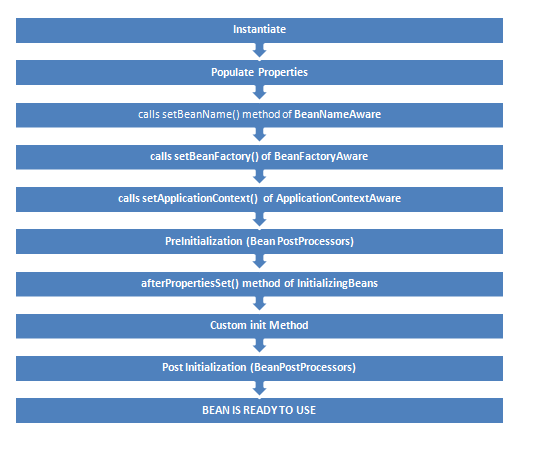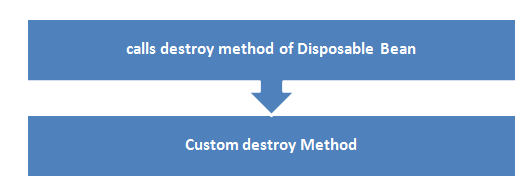This is my notes about Java Spring MVC. Content is about 30 minutes read, its purpose is:
- To refresh your memory if you already worked on it.
- Or if you are totally new, it will give you an overview, so you can kick start your first Java Spring MVC application.
# Installation
Windows:
- JDK
- Download Spring libraries (then add to build path)
# ClassPathXmlApplicationContext
At first, in Java Spring Core module, there is a Bean Factory (an objects container). You can imagine the Bean is like Object in OOP. BeanFactory allows you to access objects defined in Xml bean configuration file.
So why using object (Bean) defined in XML Bean Configuration file but not instantiate the objects in source code directly?
Using this approach, you can de-couple dependencies
You mentioned about BeanFactory, but what is its relation with ClassPathXmlApplicationContext?
The ClassPathApplicationContext (another objects container) provides additional functionalities over the BeanFactory. For example, you can use getBean function just like with BeanFactory -
./src/bean-config.xml
<?xml version="1.0" encoding="UTF-8"?>
<beans xmlns="http://www.springframework.org/schema/beans"
xmlns:xsi="http://www.w3.org/2001/XMLSchema-instance"
xsi:schemaLocation="http://www.springframework.org/schema/beans
http://www.springframework.org/schema/beans/spring-beans-3.0.xsd">
<bean id="beanId" class="Object">
<property name="message" value="Application Context Example"/>
</bean>
</beans>
./src/test_application_context.java
ApplicationContext context = new ClassPathXmlApplicationContext("bean-config.xml");
Object obj = (Object) context.getBean("beanId");
obj.publicMethod();
About advantages of ApplicationContext over the BeanFactory, beside the additional functionalities, any other bold differences?
BeanFactory is lazy loading, it only instantiate the object after calling getBean() method and call a method in the object. ApplicationContext instantiate the object as soon as the ApplicationContext is created.
About ApplicationContext, as my observation in your example, an ApplicationContext created by ClassPathXmlApplicationContext method. Is there other methods to instantiate an ApplicationContext?
Yes, you are correct, the most popular methods:
- ClassPathXmlApplicationContext: Load the Bean configuration xml file from class path (e.g. folder ./src).
- FileSystemXmlApplicationContext: Load from the system file (e.g. folder C:\beans.xml)
- XmlWebApplicationContext: Load over the internet.
In my imagination, each Bean defined in the XML file has an ID. Is it Singleton Bean (Object)?
It is about scope of Beans. The Spring framework has predefined the following scopes:
- singleton (default) (different for each ApplicationContext, i.e., different xml bean configuration file)
- prototype (instantiate new object every time getBean method is called)
- request (different for each request)
- session (different for each session)
- global_session (different for each session) Example: ``` xml
> Type of Beans is defined in "class" attribute, I guess that we have to cast the result to desired class when using getBean method (of ApplicationContext).
>Is it correct?
Yes, you are correct, following is an example (notice the PrototypeBean casting):
```java
public class TestPrototypeBean {
public static void main(String[] args) {
ApplicationContext context = new ClassPathXmlApplicationContext("beans.xml");
PrototypeBean prototypeBeanA = (PrototypeBean)context.getBean("prototypeBean");
System.out.println(prototypeBeanA);
PrototypeBean prototypeBeanB = (PrototypeBean)context.getBean("prototypeBean");
System.out.println(prototypeBeanB);
System.out.println("Is Prototype Bean A and Prototype B are same ? " + (prototypeBeanA==prototypeBeanB));
}
}
Is the Bean aware its container or current session? We might use such information, e.g, for logging.
Yes, there are over-writable methods from the call to ready-to-use:

Also before completely destroyed:

All you have to do is to implement one or some of the following interfaces:
- InitalizingBean, DisposableBean
- ApplicationContextAware, BeanNameAware, BeanFactoryAware
Can I set a custom hook method using .xml file?
Yes, you can change init-method and/or destroy-method attributes in the .xml file like this:
<bean id="beanID" init-method="myCustomInitMethod" destroy-method="myCustomDestroyMethod" class="MyClass" />
# Spring Bean Configuration Inheritance
Can we re-use some configuration in Bean configuration file? For an example, we have Students, Teachers, Professors. They are all human so they all have name and date-of-birth. Can we re-use it?
Yes, you can. Let take a look at following example:
<bean id="humanBean" class="Human">
<property name="name" value="TBD"/>
<property name="dateOfBirth" value="1900/01/01"/>
</bean>
<bean id="studentBean" parent="humanBean">
Is there other kind of inheritance?
Yes, there is other kind of inheritances you can do a configuration parent Bean by your demand:
| class attr. | abstract attr. | Desc. |
|---|---|---|
| yes | no | CAN initialize both parent and children, DON’T define “class” attribute in children Bean |
| yes | yes | CANNOT initialize parent, HAVE TO define “class” attribute in children Bean) |
| no | yes | Not use (no application) |
| no | no | Not use (no application) |
# Spring Dependency Injection
As I look in the Bean configuration (.xml file), each Bean (object) has an ID, you can initialize Bean’s (object’s) properties using
<property>tag. The property name must be published and hasgetandsetmethods associated with it. Can we initialize a Bean (object) ifclassconstructor has many arguments?
room.java
class Room{
private int roomSize;
private String teacherName;
Room(int roomSize) {
this.roomSize = roomSize;
}
public int getRoomSize() {
return roomSize;
}
public int getTeacherName() {
return teacherName;
}
public int setTeacherName(String teacherName) {
this.teacherName = teacherName;
}
}
bean-config.xml
<bean id="roomBeanId" class="Room">
<constructor-arg value="10"/>
<property name="teacherName" value="Ramond"/>
</bean>
If getBean("roomBeanId") executed, a new room will be created by the IoC at run-time.
I write an example to explain what happened in the background.
public Object getBean(String beanId) {
...
Object object = new Room(10);
((Room)object).setTeacherName("Ramond");
return object;
}
So can we use a custom defined class in properties or the constructor parameters.
Yes, we can achieve it by using constructor argument reference and/or setter reference like bellow:
<bean id="roomBeanId" class="Room">
<constructor-arg value="10"/>
<property ref="teacherBeanId" value=""/>
</bean>
<bean id="teacherBeanId" class="Teacher">
<constructor-arg value="Raymond"/>
</bean>
What if a class is singleton, could not be instantiated (there is method to get a singleton instance)?
You can use factory-method attribute in Bean definition. For an example:
ConnectionUtil.java
public class ConnectionUtil{
private Connection instance;
private ConnectionUtil() {
}
public Connection getInstance() {
return instance;
}
public String justAnotherMethod() {
return "String";
}
}
bean-config.xml
<bean id="beanId" class="ConnectionUtil" factory-method="getInstance"/>
Can we apply this approach for instance factory method? Something like relationship between a CarFactory and a Car
public class Car {
private String name;
private String color;
}
public class CarFactory {
private String name;
CarFactory(String name) {
this.name = name;
}
public Car getCar() {
return new Car();
}
}
<bean id="carFactoryBeanId" class="CarFactory">
<constructor-arg value="CarFast"/>
</bean>
<bean id="carBeanId" class="Car" factory-bean="carFactoryBeanId" factory-method="getCar" />
# Injecting collections in Spring
How about collections? Do List, Set, Map, and Props supported?
Yes, they are. Following are examples:
<bean id="countryBeanId" class="Country">
<property name="stateNameList" >
<list>
<value>State 1</value>
<value>State 2</value>
<value ref="stateBeanId3" />
<value ref="stateBeanId4" />
</list>
</property>
<property name="stateNameSet">
<set>
<value>State 1</value>
<value>State 2</value>
<value ref="stateBeanId3" />
<value ref="stateBeanId4" />
</set>
</property>
<property name="stateCode">
<map>
<entry key="stateName" value="+84"/>
<entry key-ref="stateBeanId" value-ref="stateBeanId2"/>
</map>
</property>
</bean>
An separated example for Property
public class DataSource {
private Properties dbProperties;
public Properties getDbProperties() {
return dbProperties;
}
public void setDbProperties(Properties properties) {
this.dbProperties = properties;
}
}
<?xml version="1.0" encoding="UTF-8"?>
<beans xmlns="http://www.springframework.org/schema/beans"
xmlns:xsi="http://www.w3.org/2001/XMLSchema-instance"
xsi:schemaLocation="http://www.springframework.org/schema/beans
http://www.springframework.org/schema/beans/spring-beans-3.0.xsd">
<bean id="datasource" class="DataSource">
<property name="dbProperties">
<props>
<prop key="username">root</prop>
<prop key="password"></prop>
<prop key="host">localhost</prop>
<prop key="port">3306</prop>
</props>
</property>
</bean>
</beans>
# Common issues
Written with StackEdit.